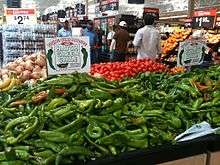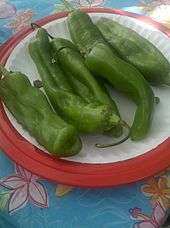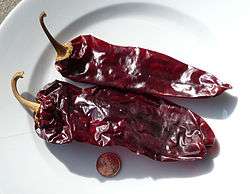New Mexico chile
| New Mexico chile | |||||||||||||||||||||||
|---|---|---|---|---|---|---|---|---|---|---|---|---|---|---|---|---|---|---|---|---|---|---|---|
 | |||||||||||||||||||||||
| Species | Capsicum annuum | ||||||||||||||||||||||
| Cultivar group | New Mexico[1] | ||||||||||||||||||||||
| Marketing names | Hatch chile, green chile, red chile, Anaheim pepper | ||||||||||||||||||||||
| Breeder | Fabián Garcia | ||||||||||||||||||||||
| Origin | New Mexico | ||||||||||||||||||||||
| Heat |
| ||||||||||||||||||||||
| Scoville scale | 0–70,000 SHU | ||||||||||||||||||||||
| |||||||||||||||||||||||
New Mexico chile or New Mexican chile (Spanish: chile de Nuevo México,[2] chile del norte[3]) is a group of cultivars of the chile pepper from the US State of New Mexico, first grown by Pueblo and Hispano communities throughout Santa Fe de Nuevo México,[4] the modern peppers were developed by pioneer horticulturist Fabián Garcia at New Mexico State University in 1894, then known as the New Mexico College of Agriculture and Mechanic Arts.[5] The New Mexico chile peppers, which typically grow from a green to a ripened red, are popular in the cuisine of the Southwestern United States, the broader Mexican cuisine, and an integral staple of New Mexican cuisine.[6] The chile pepper is one of New Mexico's state vegetables, and is referenced in the New Mexico state question "Red or Green?"[7]
Chile grown in the Hatch Valley, in and around Hatch, New Mexico, is called Hatch chile, but no one cultivar of chile is specific to that area, which is smaller than the acreage used to produce chiles with the "Hatch" label.[4] The peppers grown in the valley, and along the entire Rio Grande, from northern Taos Pueblo to southern Isleta Pueblo, are a signature crop to New Mexico's economy and culture.[8][9]
The New Mexico green chile pepper flavor has been described as lightly pungent similar to an onion, or like garlic with a subtly sweet, spicy, crisp, and smoky taste.[10] The ripened red retains the flavor, but adds an earthiness and bite while aging mellows the front-heat and delivers more of a back-heat.[11][12] The spiciness depends on the variety of New Mexico chile pepper.[13]
History
Many types of peppers were first grown by Pueblo residents, who continue to grow their own peppers each with a distinct pungency, sweetness, taste, and heat. For example, the Zia Pueblo pepper has a bitter-sweet flavor when it matures into its red color. When the Spanish arrived, they introduced European cultivation techniques to the chile pepper, and eventually created cultivars in their towns.[14]
The New Mexican type cultivars were developed by pioneer horticulturist, Fabián Garcia,[4][15] whose major release was the 'New Mexico No. 9' in 1913.[16] These cultivars are "hotter" than others to suit the tastes of New Mexicans in their traditional foods. Selective breeding began with 14 lineages of 'Pasilla', 'Colorado', and 'Negro' cultivars, from throughout New Mexico and Southern Colorado. These first commercially viable peppers were created to have a "larger smoother, fleshier, more tapering and shoulderless pod for canning purposes."[17]
Internationally renowned expert on chile genetics, breeding, and germplasm evaluation, Paul Bosland, founded the Chile Pepper Institute at New Mexico State University to study New Mexico's iconic state vegetable and peppers from around the world.[18]
Cultivation
New Mexico chile peppers are grown from seeds – and each of the individual pepper types is specifically bred and grown to be disease-resistant and provide consistent and healthy plants within their specific regions. Altitude, climate, soil, and acreage affects a crop's taste and heartiness, making the New Mexican region unique for plant propagation. The Rio Grande bosque, mountains, and high deserts provide the appropriate regional environment for growing chiles. To ensure that a variety's lineage remains disease-resistant and maintains optimal growth within its heritage region, seeds from specific plants are carefully selected. An example of a New Mexican chile grown outside the state is the 'Anaheim' pepper which are extremely resilient in multiple altitudes. A quirky aspect of the New Mexico chile pepper regards reintroducing seeds from their heritage soil since each successive generation becomes susceptible to disease and it loses its flavor. Therefore, chile pepper farmers usually order seeds from their heritage soils, every few generations, to reinvigorate their crop. This allows the New Mexico chile pepper growers to perpetuate successful productions.[19][20][21] Seed distributors and sellers from New Mexico, California, and Colorado provide this service to farmers.
New Mexico chile peppers grown in New Mexico are the most sought after, since their flavor, texture, and hardiness are heavily dependent on their growing environment. The peppers were originally grown by the Pueblo, and each of their distinct Pueblo peppers grows best in its heritage soil. This same trend has continued with other New Mexico chile peppers, those grown by the farmers among the Spanish, Mexican, and American frontiersmen. Among the New Mexico-grown chile peppers, the ones with the most accolades are grown along the Rio Grande, especially along the Hatch Valley.[22][23]
A certification program was started in 2014, New Mexico Certified Chile, attempting to certify the growing of New Mexico chile peppers. The program tries to protect New Mexico chile consumers from falsely labeled products, while protecting farmers from a potential diminishing of demand, and to allow larger amounts of New Mexico chile to be grown within the state. Since the program is rather new, it has garnered some criticism, especially in regard to restricting smaller farmers who have been growing peppers from lineages of more than 400 years of seeds.[24][25]
Hatch chile
Hatch chile refers to varieties of species of the genus Capsicum which are grown in the Hatch Valley, an area stretching north and south along the Rio Grande from Arrey, New Mexico, in the north to Tonuco Mountain to the southeast of Hatch, New Mexico. The soil and growing conditions in the Hatch Valley create a unique terroir[26] which contributes to the flavor of chile grown there. Most of the varieties of chile cultivated in the Hatch Valley have been developed at New Mexico State University over the last 130 years.
Hatch chile can be purchased locally in many parts of the Southwest, and is distributed throughout the United States by companies such as World Variety Produce. Other distributors sometimes use the "Hatch" name, but do not actually grow and process their chile in the Hatch Valley.[27] To protect Hatch and other New Mexican growers, state legislators passed a 2012 law prohibiting the sale in New Mexico of peppers described as "New Mexican" unless they were grown in New Mexico or came with a prominent "Not grown in New Mexico" disclaimer.[28] Chiles grown around the town are marketed under the name of the town, and are often sold fresh-roasted in New Mexico and neighboring states in the early autumn.[29]
Pueblo chiles
Pueblo chiles have been cultivated by the Puebloan peoples of New Mexico for centuries. The Acoma Pueblo chile pepper is mild, with a lightly flavorful pungency.[30] The Isleta Pueblo chile pepper becomes a fruity sweet flavor as it grows into its red chile state. The Zia Pueblo chile pepper becomes a bitter-sweet flavor when it matures into its red color, and its heat is similar to the 'Heritage 6-4'.[31]
These ancient Pueblo varieties should not be confused with chile peppers grown in Pueblo, Colorado, a variety of the guajillo chili, otherwise known as the mirasol pepper. They are distinct in and of themselves, but are not related to New Mexico chile.[32]
Rio Grande chile
Along the rest of the Rio Grande, outside of the Hatch Valley, multiple other locations grow award-winning chiles in their own right.
Towns and cities across New Mexico have strong chile traditions, including; Chimayo, Española, Corrales, Lemitar, and San Antonio; and from Bosque Farms to Los Ranchos de Albuquerque in the Albuquerque area.
Outside of New Mexico
Anaheim pepper
| Anaheim pepper | |
|---|---|
| Heat |
|
| Scoville scale | 500–2,500 SHU |
An Anaheim pepper is a mild variety of the cultivar 'New Mexico No. 9' and commonly grown outside of New Mexico. It is related to the 'New Mexico No. 6 and 9', but when grown out of state they have a higher variability rate. The name 'Anaheim' derives from Emilio Ortega, a farmer who brought the seeds from New Mexico to the Anaheim, California, area in 1894.[33][34][35]
The chile "heat" of 'Anaheim' varies from 500 to 2,500 on the Scoville scale.[36]
Uses
Food
| Nutritional value per 75 grams | |
|---|---|
| Energy | 30 kJ (7.2 kcal) |
|
7.1 g | |
| Sugars | 3.82 g |
| Dietary fiber | 1.1 g |
|
0.15 g | |
| Saturated | 0.016 g |
| Monounsaturated | 0.008 g |
| Polyunsaturated | 0.082g |
|
1.5 g | |
| Vitamins | Quantity %DV† |
| Vitamin A equiv. |
111% 884 μg5% 503 μg544 μg |
| Thiamine (B1) |
6% 0.068 mg |
| Riboflavin (B2) |
6% 0.068 mg |
| Niacin (B3) |
5% 0.712 mg |
| Pantothenic acid (B5) |
1% 0.046 mg |
| Vitamin B6 |
16% 0.209 mg |
| Folate (B9) |
4% 17 μg |
| Vitamin C |
219% 181.9 mg |
| Vitamin E |
3% 0.52 mg |
| Vitamin K |
10% 10.7 μg |
| Minerals | Quantity %DV† |
| Calcium |
1% 14 mg |
| Iron |
7% 0.9 mg |
| Magnesium |
5% 19 mg |
| Phosphorus |
5% 35 mg |
| Potassium |
5% 255 mg |
| Sodium |
0% 5 mg |
| Zinc |
2% 0.22 mg |
| Other constituents | Quantity |
| Water | 65.8 g |
|
| |
| |
| †Percentages are roughly approximated using US recommendations for adults. | |


Green chiles are served roasted and peeled, whole or diced, and in various sauces. The most common uses for these diced chiles, or sauces, is in enchiladas, burritos, burgers, french fries, or rice. They are also served whole raw or as fried or baked chiles rellenos. New Mexican-style chiles rellenos follow the much more traditional Mexican technique of being covered with egg batter and fried, although variations and casseroles do exist.
In addition to local restaurants, many national food chains such as McDonald's and Jack in the Box offer green chile on many of their menu items.[37]
The red chile, the matured green chile, is frequently dried and ground to a powder. These dried or powdered peppers are turned into a red chile sauce. The dried peppers are rehydrated by boiling in a pot, and then blended with various herbs and spices, such as onion, garlic, and occasionally Mexican oregano. The red chile powder is usually simply blended with water, herbs, and spices.
Serving both red and green chile sauces on a dish is sometimes referred to as "Christmas" style. Both green and red chile can be dried and turned into a powder, though this is more common with red chile.
Roasting
Chile roasting refers to roasting of green chiles, most commonly occurring during harvest season, in autumn, throughout New Mexico. The process can be done at the time of purchase, in an oven (horno), or at home.[38]
The commercial process, done at purchase, usually involves an operator taking the part as chile roaster which involves standing near and turning a cylindrical cage drum over propane fueled flames, ensuring the chile pods are heated on every side, as they shed their skins; this ensures the chile skins blister appropriately, to allow for easier peeling of the chile. This process is the most popular method, since the smell has become a staple during the early New Mexican autumn, it offers a physical display of the chile, it offers the sound of the chiles crackling, the sight of the blistering and falling skins, accompanied by the widely distributed smell of the roasting peppers.[39][40]
Horno-roasting the chiles, while done less often, is a traditional method of roasting the chile. A more common method is simply roasting over an open flame on gas stove-tops and grills.
Art
A ristra is an arrangement of drying chile pods, and is a popular decorative design in the state of New Mexico. Some households use ristras as a means to dry and procure red chile.
The red and green chile peppers are often depicted in New Mexican artwork as symbols of New Mexican cuisine.
Sub-cultivars
Though most New Mexico type peppers are long pod-type peppers, that ripen from green to red, the multitude of New Mexico type cultivars have a slight variance in taste, and widely varying appearances and heat levels.[41][42] Some varieties may turn yellow, orange, or brown.
The most common New Mexico chile peppers are the 'New Mexico 6-4', 'Big Jim', 'Sandia', 'No. 6', and 'No. 9' cultivars. The improved 'Heritage 6-4', 'Heritage Big Jim', and 'Sandia Select' cultivars provide a better yield and uniformity. Peppers like the 'Chimayo', 'Velarde', 'Jemez', 'Escondida', 'Alcalde', 'San Filipe', 'Española', and several others, represent what is known as the New Mexico's unique landrace chiles, which provide their own unique tastes and usually command a higher price.
| Cultivar | Description | Length | Width | Scoville heat units |
|---|---|---|---|---|
| Conquistador | A very mild non pungent pepper, green before ripening into a red color. | 6.5 inches (17 cm) | 0 | |
| Eclipse | Part of the Sunrise, Sunset, and Eclipse pepper line; Eclipse matures into a brown color. | 5.1 inches (13 cm) | 1.9 inches (4.8 cm) | 300 ~ 500 |
| R Naky | Developed by Roy Nakayama in 1985, from a mix of the Rio Grande, 6-4, and Bulgarian Paprika. | 5.5 inches (14 cm) | 500 ~ 1,000 | |
| Sunrise | Part of the Sunrise, Sunset, and Eclipse pepper line; Sunrise matures into an orange color. | 7.1 inches (18 cm) | 1.5 inches (3.8 cm) | 500 ~ 1,000 |
| Española | An old chile pepper, has a slightly stronger pungent and bitter flavor and matures early to red, first grown by the Spanish settlers in the San Juan Valley, near modern-day Española. | 4.9 inches (12 cm) | 1.5 inches (3.8 cm) | 1,500 ~ 2,000 |
| Española Improved | Hybridization of Sandia and Española. Provides Española's taste and early maturation, with a better yield, and larger peppers. | 6.0 inches (15 cm) | 1.75 inches (4.4 cm) | 1,500 ~ 2,000 |
| Joe E. Parker | Thicker walled 6-4, with a heat variance based on growing conditions. | 6.5 inches (17 cm) | 2.0 inches (5.1 cm) | 1,500 ~ 4,500 |
| Heritage 6-4 | A 200-seed sample of the original "New Mexico 6-4", obtained from the Plant Germplasm Preservation Research Unit (PGPRU) at the National Center for Genetic Resources Preservation, in Ft. Collins, Colorado. The PGPRU received the seed in 1962 and placed it in cryogenic storage. The flavor of the plant was rehabilitated from these seeds. | 6.7 inches (17 cm) | 3.7 inches (9.4 cm) | 1,559 |
| 6-4 | An heirloom variety developed by Fabián Garcia. | 6.6 inches (17 cm) | 3.8 inches (9.7 cm) | 1,786 |
| Rio Grande | 2,500 ~ 5,000 | |||
| Sandia | Released by Dr. Roy Harper in 1956 by cross breeding a Numex No. 9 type (originally developed by Dr. Fabian Garcia) with a Californian Anaheim-type chile. | 6-7 inches | 5,000 ~ 10,000 | |
| Big Jim | Jim Lytle worked with Dr. Nakayama and New Mexico State University (NMSU) to develop a hatch chile that was fondly named Big Jim. This variety holds the record for the longest chile to date, which measured in at 17 inches in 2012.[43] | 7-12 inches | 6,510 | |
| Heritage Big Jim | 9,482 | |||
| Barker's Hot | 15,000 ~ 30,000 | |||
| Luci Fairy | 30,000 ~ 50,000 | |||
| XX Hot | 60,000 ~ 70,000 | |||
References
- ↑ Boning, C.R. (2010). Florida's Best Herbs and Spices: Native and Exotic Plants Grown for Scent and Flavor. Pineapple Press. p. 63. ISBN 978-1-56164-453-7. Retrieved April 15, 2018.
- ↑ Novas, H. (2013). La Buena Mesa: La autentica cocina latinoamericana en los Estados Unidos (in Spanish). Knopf Doubleday Publishing Group. p. 270. ISBN 978-0-307-80076-3. Retrieved April 15, 2018.
- ↑ "The Everyday Chef: How To Prep Chiles & Make A Mild Red Chile Sauce". Fruits & Veggies More Matters. Retrieved April 15, 2018.
- 1 2 3 DeWitt, D.; Bosland, P.W. (2009), The Complete Chile Pepper Book: A Gardener's Guide to Choosing, Growing, Preserving, and Cooking, Timber Press, ISBN 978-0881929201
- ↑ Urig, K. (2015). New Mexico Chiles: History, Legend and Lore. American Palate. Arcadia Publishing Incorporated. ISBN 978-1-62585-353-0. Retrieved April 15, 2018.
- ↑ "A Spicy Guide to New Mexican Cuisine". Spices Inc.
- ↑ "State Symbols". New Mexico Office of the Secretary of State. Retrieved 29 July 2014.
- ↑ "New Mexico Chile Industry Value, 1977-2009" (PDF). Chile Pepper Institute. Las Cruces, NM: Department of Plant and Environmental Sciences, New Mexico State University.
- ↑ Montoya Bryan, Susan (10 September 2014). "New Mexico's green chile harvest in full swing". Associated Press. Retrieved 9 May 2015.
- ↑ Host: Adam Richman (2011). "Travis on a Silver Platter" Man v. Food Nation (Television).
- ↑ "Seed Catalog, Specializing in New Mexico Chile Seeds" (PDF). Midwest Chileheads. 2015.
- ↑ "Cook's Thesaurus: Dried Chiles". Cook's Thesaurus. Retrieved 16 February 2015.
- ↑ Anthony Bourdain: Parts Unknown, Season 2, Episode 4, "New Mexico". (2013)
- ↑ "Chile Roasting in New Mexico". New Mexico History. Office of the State Historian. Retrieved 15 February 2015.
- ↑ Bosland, Paul. "Fabián García – Pioneer Hispanic Horticulturist" (PDF). Chile Pepper Institute. New Mexico State University. Retrieved 10 May 2015.
- ↑ Coon, Danise; Votava, Eric; Bosland, Paul W. (November 2008). "The Chile Cultivars of New Mexico State University, Research Report 763" (PDF). Chile Pepper Institute. Las Cruces, NM: Department of Plant and Environmental Sciences, New Mexico State University. Archived from the original (PDF) on 23 September 2015. Retrieved 12 December 2014.
- ↑ Fabian Garcia as quoted in DeWitt, D.; Bosland, P.W. (2009), The Complete Chile Pepper Book: A Gardener's Guide to Choosing, Growing, Preserving, and Cooking, Timber Press, p. 53, ISBN 978-0881929201
- ↑ "Paul W. Bosland". The NMSU College of Agricultural, Consumer and Environmental Sciences. New Mexico State University. Retrieved 10 May 2015.
the co-founder and director of the Chile Pepper Institute at New Mexico State University
- ↑ Bosland, Paul W. (2012). "NuMex Heritage 6-4' New Mexican Chile Pepper" (PDF). Chile Pepper Institute. Las Cruces, NM: Department of Plant and Environmental Sciences, New Mexico State University. Archived from the original (PDF) on 2015-03-19.
- ↑ "Pepper Chile Anaheim NuMex Joe E. Parker Seeds". Botanical Interests. Heirloom Seeds, Organic Seeds | Seed Catalog. Retrieved 25 February 2015.
- ↑ Bosland, Paul W.; Walker, Stephanie (May 2014). "Growing Chiles in New Mexico, Guide H-230" (PDF). Chile Pepper Institute. Las Cruces, NM: Department of Plant and Environmental Sciences, New Mexico State University.
- ↑ "Hatch Green Chile". Frieda's Inc. - The Specialty Produce Company. 27 April 2012. Retrieved 12 February 2015.
- ↑ Cornish, Audie (31 July 2011). "It's Law: New Mexico Green Chilies Are Special". NPR.org. Retrieved 15 February 2015.
- ↑ DeWalt, Rob (26 August 2014). "Chile Wars". Santa Fe Reporter. Retrieved 10 May 2015.
- ↑ Green, Eric (22 August 2014). "Coalition pokes holes in New Mexico's new chile certification program". KOAT.com. Retrieved 15 February 2015.
- ↑ Herrera, Tilde (22 August 2010). "New Mexico green chiles headed to Bay Area". San Francisco Chronicle.
- ↑ "U.S.: the Hatch green chile identity crisis". FreshFruitPortal.com. 8 August 2013. Retrieved 29 July 2014.
- ↑ "New law requires full chile disclosure in New Mexico". KOAT. 7 April 2013. Retrieved 29 July 2014.
- ↑ "The Hatch Chile Festival, A Visit to the Chile Capital of the World!". New Mexico Travel. Retrieved 9 May 2015.
"Hatch Chile" is not actually a variety of pepper, but is a term used to describe peppers of several different varieties grown in the area.
- ↑ "Database of Chilli Pepper Varieties". The Chile Man. Retrieved 16 February 2015.
- ↑ "Zia Pueblo - Live Chile/Pepper Plant". Chile Plants. Retrieved 16 February 2015.
- ↑ Owen, Rob (20 November 2011). "Hot in Pueblo: Mirasol green chiles give this Pittsburgh-like town its flavor". Pittsburgh Post-Gazette.
- ↑ "Ortega, Questions and Answers". Ortega.com. B & G Foods, Inc. Retrieved 10 May 2015.
- ↑ "Ortega History". Ortega.com. B & G Foods, Inc. Retrieved 10 May 2015.
- ↑ Walsh, R. (2013). The Hot Sauce Cookbook: Turn Up the Heat with 60+ Pepper Sauce Recipes. Clarkson Potter/Ten Speed/Harmony. p. 13. ISBN 978-1-60774-427-6. Retrieved 10 February 2015.
- ↑ "Anaheim Pepper". Truestar Health Encyclopedia. 2007. Archived from the original on 28 September 2007. Retrieved 17 October 2007.
- ↑ Denniston, Jennifer (26 August 2014). "Some like it hot: green chile tour of New Mexico". Lonely Planet. Retrieved 9 May 2015.
even McDonalds offers green chile on its burgers
- ↑ Robbins, Ted (6 October 2013). "That Smoky Smell Means Chile Roasting Season In New Mexico". NPR.org. Retrieved 16 February 2015.
- ↑ O'Catherine, Aileen (1 January 2010). "Smell that Green Chile Roasting!". About.com Travel. Retrieved 11 February 2015.
- ↑ Weinzweig, Ari (20 October 2008). "A Guide to New Mexico Green Chile « Zingerman's Roadhouse, Ann Arbor, MI – Really Good American Food!". Zingerman's Roadhouse, Ann Arbor, MI – Really Good American Food!. Retrieved 11 February 2015.
- ↑ "Growing Peppers in New Mexico Gardens, Guide H-240" (PDF). Chile Pepper Institute. Las Cruces, NM: Department of Plant and Environmental Sciences, New Mexico State University. June 1997.
- ↑ "Just How HOT Are My Chiles?". Uncle Steve's HOT Stuff. 2010.
- ↑ "Lumbre Chile Powder ǀ Hatch New Mexico Grown Chile". www.spicesinc.com. Retrieved 2018-05-16.
